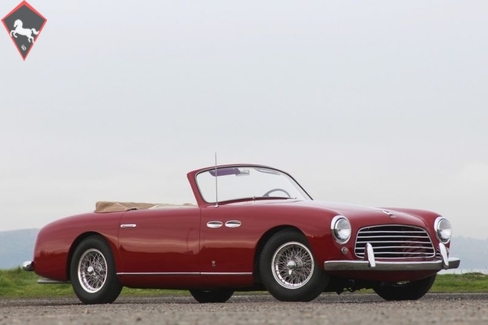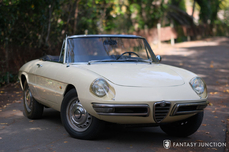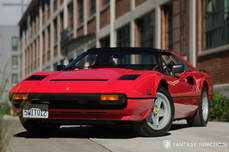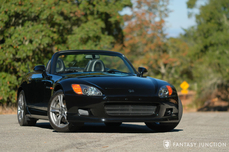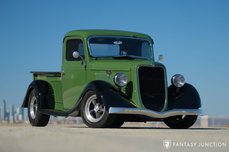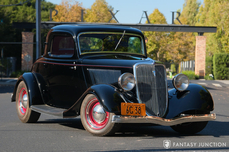Siata Other Ford V8 1952
General description :
1952 SIATA-Ford
s/n 208SL1006613
Red with Parchment
SIATA is among one of the most celebrated Italian car companies of the 1950’s. Known for their superbly crafted vehicles, the first production SIATA appeared in 1948. SIATA later built the iconic 208S and SC as well as the capable 300BC, many of which were formidable competitors on the track. But it was their stunning bodies, crafted by the finest coachbuilders of the period, which resulted in cars considered among the most beautiful of the 1950’s. SIATAs were frequently seen in competition both in Europe and the US, but were as much at home in elegant settings as they were on the Mille Miglia.
This stunning, one of a kind SIATA was originally commissioned by Jimmy Mulgrew of Euclid Ford, Euclid, Ohio. Mulgrew called on racecar driver Dick Irish (best known for his class win at Sebring, 1952 in a SIATA Daina 1400cc Gran Sport) who had been working with Mulgrew, proposing a plan to build a racecar on a modified Ford chassis. This car would serve both as a promotion tool for the Euclid Ford dealership while meeting the sporting desires of Mr. Mulgrew.
Upon written request to Ford Motor Company, Edsel Ford himself replied denying Mulgrew's request for a “Police Special” chassis suitable for the durable needs of performance. Undeterred, Mulgrew dispatched Dick Irish to Tony Pompeo’s New York dealership (East Coast importer of SIATA, Bandini, Stanguellini etc.) driving a 1951 two-door-sedan chosen from the Euclid Ford sales lot. Irish delivered the Ford sedan at the NY docks, instructing Pompeo to send the car to SIATA as the starting point for their custom Ford-based sports car. Mulgrew and Irish patiently waited while the car was crafted, expecting a sporting hardtop or coupe similar to the Italmeccanica IT-160, which they had recently seen at Walkins Glen.
Approximately six months later the car returned as a SIATA, bearing the chassis number 208SL1006613, surprisingly as a convertible. The car arrived with a SIATA derived frame sporting Ford suspension, drivetrain, instruments, and various other trim, but completely lacking the Ford frame. Experts surmise that the car was disassembled in New York prior to shipping as a cost saving measure, sending only the most viable parts to complete the special bodied car. Whether Pompeo sent the entire car or simply the critical components may never be known, but the chassis on the car today is completely SIATA derived. The resultant car was beautifully finished and quite fast, surprising many of the people involved at Euclid Motors. After Mulgrew displayed the car at his dealership and used it for his own personal enjoyment, it was subsequently sold through Alfred Momo's dealership in the late fifties.
The SIATA shuttled from various owners through the 1970’s and 1980’s (detailed ownership history on file with the car) when it fell into disrepair and in 1988 was brought to running condition, frame rust was repaired, only to return dormant once again for almost 20 more years. By 2005 Jerry Bensinger and Daniel Rapley had acquired the car, subsequently selling it to the current owner who undertook an ambitious and detailed restoration, resulting in the beautifully finished vehicle seen here today.
In 2005, the car was sent to Germany whereby Ugo Bernhadt (proprietor of Bernhardt Karosseriebau) completely disassembled the entire aluminum body executing metal artisanship and refinement consistent with craftsmanship fitting to a car of this stature. Once completed, the car was shipped back to the US where it was reunited with the current owner and his restoration partner Dave Torrey of Absolute Engineering, Goleta, CA. Together, the restoration team removed and refinished all parts to high standards with particular attention to detail and authenticity. The restoration took several years to complete in order to properly document and present the car accurately.
The exterior finish is beautifully done with high quality paint, taught canvas top, accented with elegantly laced Boranni wire wheels and Excelsior tires. Hood, doors, and trunk are properly fitting with excellent closure and smooth operation. The minimal chrome trim is delicately finished with excellent gloss. Front and rear bumpers are nicely finished, revealing subtle design features that are properly polished, not worn or over-buffed. The delicate taillights are tastefully trimmed with the finest edging of chrome and the front lights feature chrome bezels also with excellent finish. The glass is free from any flaws and the disappearing door handles work smoothly while opening and closing the doors with ease.
The interior is elegantly trimmed in off white leather accented by matching gloss red paint and a delightful assortment of instruments. The finishes throughout are well done with high quality materials and attention to detail particularly on the door panels, which feature fine stitching, chrome trim, and a nice array of sophisticated trim which cleverly elevates the appearance of the American car accessories used in the original construction.
Under the hood, beauty and accuracy continue with wonderful finishes on the flathead V8 engine including Offenhauser heads and dual carburetors with custom constructed quad air filters that lead into dual long-ram intakes. The radiator is shrouded with an extension to aid in cooling due to the longer wheelbase. The engine bay is finished once again using period correct materials, fasteners, and wiring to complete the authentic look of this car. The trunk is finished with matching carpet and a full size spare housing a fifth Boranni wire wheel. The undercarriage is as nicely finished as the rest of the car with proper coatings, showing evidence of mild use since the restoration was completed in 2014.
The car starts and settles in smoothly to idle. The clutch is easily engaged with the gearbox being smooth and properly positioned for shifting. The large steering wheel is light in your hands even when slow turns require some arm muscle. Acceleration is quite good given the weight of the car while cornering is appropriate for cars of this period. The brakes and suspension are well matched to this car, delivering a nice overall driving experience – leisurely but purposeful, owing to the more potent V8 engine. Once at speed, the driver position and command of the road is stately but sporting – a tribute to the combined Italian styling and American power. The car is accompanied by a notebook documenting the restoration, history of ownership and notations from various interviews and experts, photographs of the car at various points in its history, and ownership documents.
Beautiful Stabilimenti Farina coachwork, gorgeous elegant colors, and a faithfully accurate restoration all combine to present a wonderful piece of Italian automotive history. This SIATA is not only capable of delighting even the most discerning car enthusiasts at any major concours, tour, or specialty event, it is sure to be an ongoing treasure to any collector who enjoys the rare combination of both automotive excellence and elegance in their stable.
http://fantasyjunction.com/cars/1928-Siata%20-Ford-Ford%20V8
1952 Siata Other Ford V8 is listed sold on ClassicDigest in Emeryville by Fantasy Junction for $269500.
Car Facts
Car type : Car Make : Siata Model : Other Model Version : Ford V8 Engine size : 0.0 Model Year : 1952 Location : Emeryville
Sold
Seller Information
Sold
Other cars listed for sale by this dealer
About Siata
Siata, an Italian automobile manufacturer, gained recognition for its production of small, high-performance sports cars primarily during the 1950s and 1960s. The company's name stands for "Società Italiana Auto Trasformazioni Accessori" (Italian Company for Automobile Transformations and Accessories), reflecting its early focus on car modifications and accessories.Narrative History of Siata:
Foundation: Siata was founded in Turin, Italy, in 1926 by Giorgio Ambrosini. Initially, the company specialized in tuning and modifying Fiat cars to improve their performance and appearance.
Early Years: Siata gained attention for its racing successes with modified Fiats, which helped establish its reputation as a performance-focused brand.
Post-WWII Expansion: After World War II, Siata started producing its own cars. They were often based on Fiat mechanicals but featured modified engines and unique bodywork, catering to enthusiasts looking for enhanced performance.
Siata Models and Technical Specifications:
Siata Amica:
Amica 600 (1948-1952): This was one of Siata's earliest models, based on the Fiat 600. It featured a modified engine and other performance enhancements.
Siata Spring:
Spring (1967-1970): This was a small convertible powered by a Fiat engine. It was designed for everyday use rather than high performance.
Siata 208/300BC:
Siata 208 (1953-1955): The Siata 208 was a sporty coupe powered by a 2.0-liter V8 engine, delivering impressive performance for its size.
Siata 208S:
Siata 208S (1953-1955): This model was an open-top sports car powered by the same 2.0-liter V8 engine as the 208. It was designed for enthusiasts seeking high performance and elegant styling.
Siata Daina:
Daina (1950-1958): The Daina was a series of grand tourers available in various body styles (coupe, convertible, etc.) and powered by a range of engines, including 1.5 to 2.0-liter options.
Siata 300 BC Spyder:
Siata 300 BC (1953-1958): This was a race-focused, lightweight sports car equipped with a potent 3.0-liter V8 engine, showcasing Siata's commitment to high-performance automobiles.
Siata Coupe and Roadster:
Siata Coupe and Roadster (1952-1954): These models featured different body styles powered by smaller displacement engines, offering a blend of performance and style.
Legacy:
Siata's cars were known for their combination of performance, style, and exclusivity. While the company ceased car production in the late 1960s, its impact on automotive history remains significant, especially among collectors and enthusiasts who appreciate Siata's hand-built sports cars' craftsmanship and performance-oriented approach.
